Navigation
Install the app
How to install the app on iOS
Follow along with the video below to see how to install our site as a web app on your home screen.
Note: This feature may not be available in some browsers.
More options
You are using an out of date browser. It may not display this or other websites correctly.
You should upgrade or use an alternative browser.
You should upgrade or use an alternative browser.
How to Quarantine
- Thread starter Humblefish
- Start date
- Tagged users None
- Joined
- Feb 15, 2018
- Messages
- 504
- Reaction score
- 248
Well what did you decide to do?
I placed him in QT. 50 days without any issues seems good to me.
- Joined
- Feb 15, 2018
- Messages
- 504
- Reaction score
- 248
Oops I meant I placed him in DT.Sorry you misunderstood.
Did you put him in the DT or still waiting?
- Joined
- May 3, 2020
- Messages
- 855
- Reaction score
- 707
How to Setup a Quarantine Tank
The following are the bare essentials:
Optional/recommended equipment:
- Aquarium (10-30 gallons seems to work for most people. Bigger QT lets you house more fish and gives you more wiggle room when it comes to ammonia. Smaller QT is cheaper, easier to maintain and can be setup/broke down quickly.)
- Heater and thermometer
- Small powerhead or air pump and sponge filter, for circulation & gas exchange.
- Freshly mixed saltwater which has been fully dissolved and circulating for at least 24 hours.
- Light (can just be a simple, one bulb fixture)
- Hang on the back (HOB) power filter, where a “seeded” sponge (explained later) can be added
- Egg crate (used on lighting panels), which can easily be cut with snips to build a custom top to prevent fish from jumping
- PVC elbows (see pic below) used as “caves” in which the fish hide
- Seachem Ammonia Alert badge (see pic below)
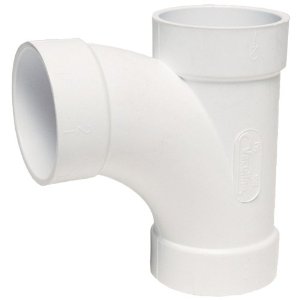
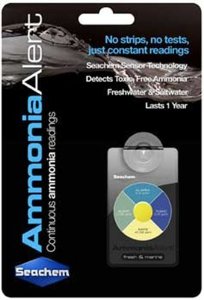
Scenario 1 (Simple QT with air pump + sponge filter):
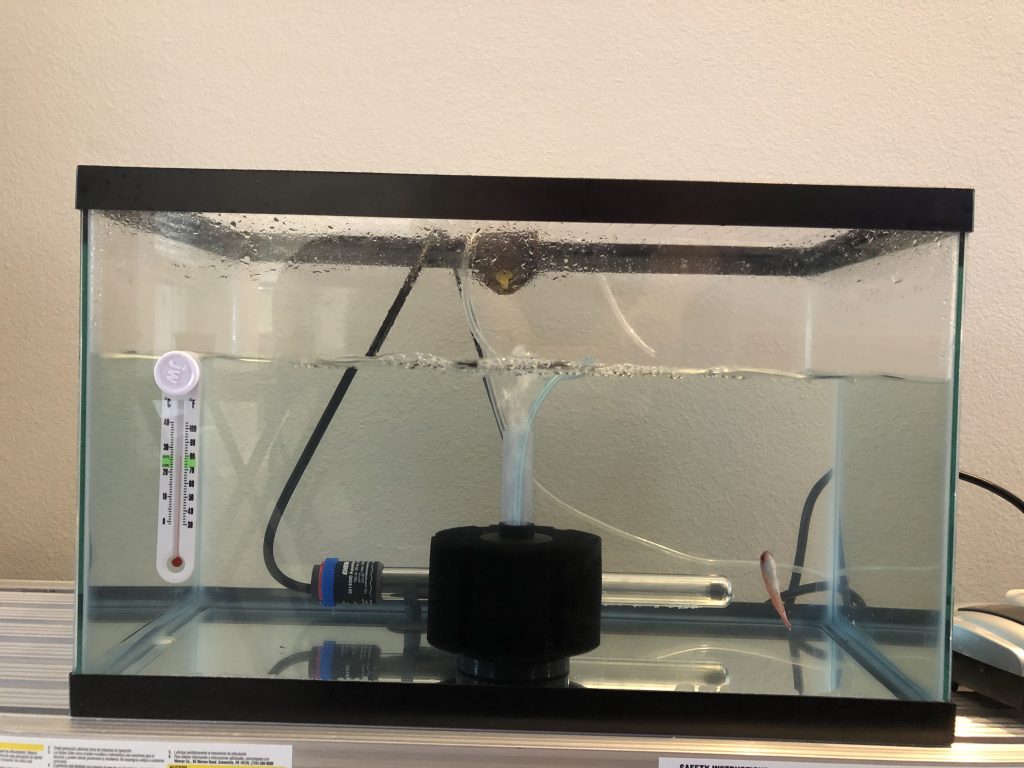
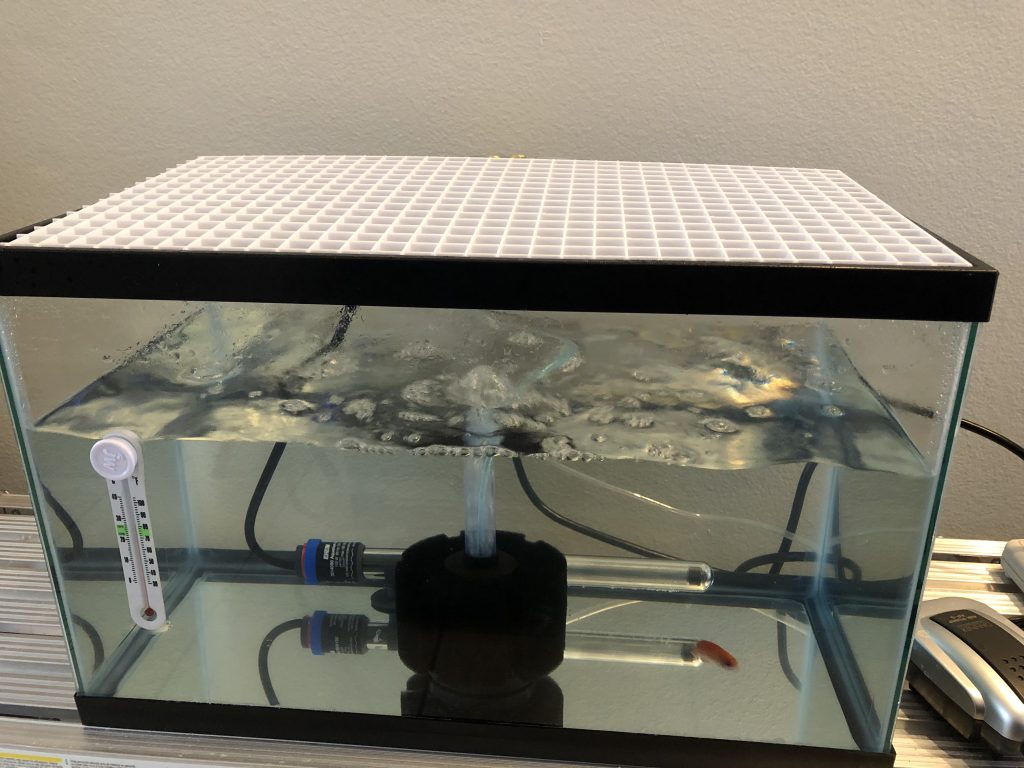
Scenario 2 (More elaborate QT with HOB power filter - Seachem Tidal, Aquaclear and Bio-wheel are all good options):
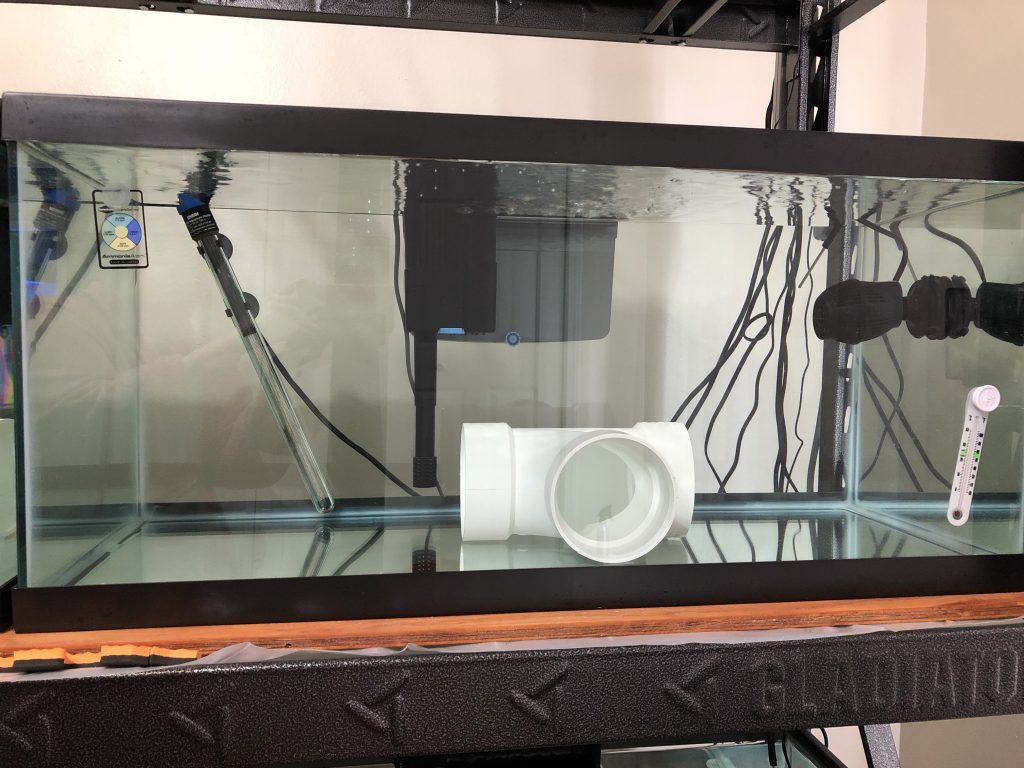
A small amount of sand is fine in QT, but rock is best avoided as it will absorb many medications. However, one or two small pieces of live rock may be added for ammonia control, so long as they are coming from a disease-free tank. The live rock will need to be removed once a disease is spotted and before medications are used. Furthermore, the live rock must be considered “contaminated” once exposed to a fish disease, and sterilized in a chlorine:water (1:10 ratio) solution. Using a lid is very important to prevent fish from jumping out. As mentioned previously, egg crate can be used, but sometimes it is necessary to sew screen under the eggcrate top to prevent small fish from jumping through the holes:
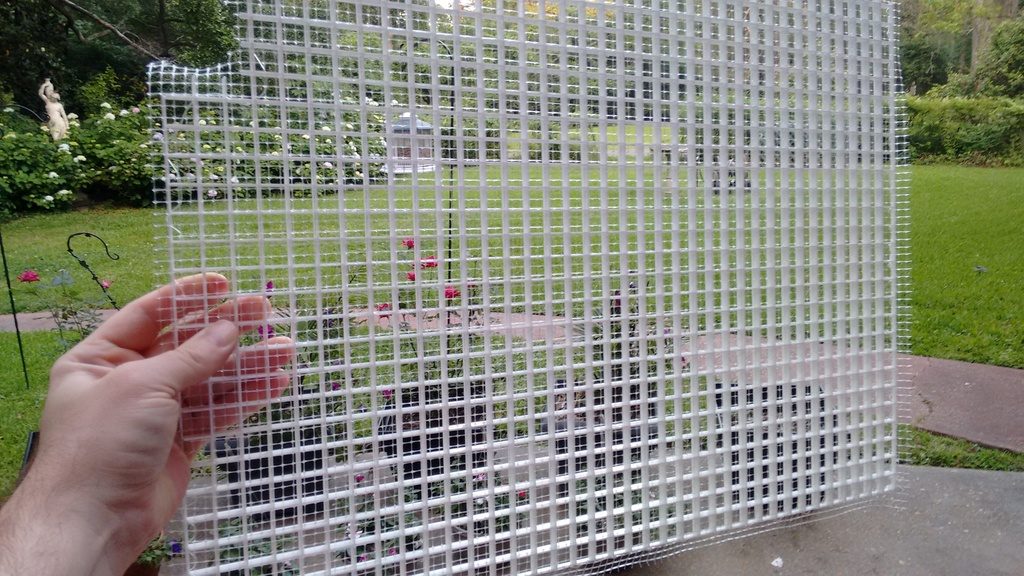
Ammonia Control & Oxygen
Toxic ammonia, caused by fish urine/poop and uneaten food, needs to be closely monitored in QT. You can use a test kit (so long as no medications are present) or a Seachem Ammonia Alert badge (works even in the presence of medications.) Even the smallest traces of ammonia are toxic!
In Scenario 1, performing water changes is your best option for controlling ammonia. You can also use an ammonia reducer such as Amquel or Prime provided you follow the rules outlined here: https://www.reef2reef.com/threads/psa-prime-safe-to-use-with-copper-power.653521/
With Scenario 2 the use of “seeded” bio-media can help to break down ammonia. I personally use a Seachem Tidal power filter, utilizing the "Matrix" bio media that comes with it. Similarly, Aquaclear contains a foam insert and the Bio-wheel itself can be seeded with nitrifying bacteria for use as biological filtration in QT. Bio media can be seeded with live bacteria in one of two ways:
- Place it in a high flow area of your DT’s sump (or you can put it behind the rocks) for at least one month prior to QT. This one month allows time for enough beneficial bacteria to transfer over.
- Dose a "bacteria in a bottle" product, such Bio-Spira, Seachem Stability or Dr Tim's Nitrifying Bacteria, into the QT a few days before purchasing fish. Below are pics of bio-media discussed which can be seeded with live bacteria - Seachem Matrix, Aquaclear's foam insert and the Bio-wheel, respectively:
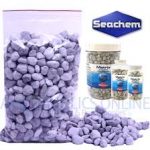
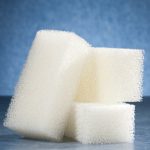
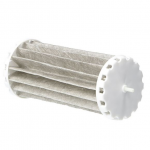
It is also crucial to provide sufficient gas exchange (oxygen) in QT, especially when using medications. One can accomplish this by creating a "disturbance" at the surface of the water by using a sponge filter, pointing a powerhead upwards or via HOB power filter:
Quarantine Protocols
Some prefer to just observe in quarantine and not use any medications unless necessary. This strategy can work, but it is important to set aside enough time in your day to observe for key behavioral symptoms of disease. These include loss of appetite, heavy breathing, scratching, flashing, head twitching, erratic swimming behavior, swimming into the flow, etc. Of course, also look for visible physical symptoms of disease: white dots or growths, dark spots, red sores, frayed fins, etc. If treatment is needed, ensure you can quickly transform your "observation tank" into a "hospital tank" - one without rock, UV, carbon, poly filter, etc. which will absorb medications. Alternatively, you can transfer the fish to a hospital tank for treatment - provided it is at least 10 feet away to account for aerosol transmission.
A once popular QT protocol is tank transfer method. However, the recent prevalence of Marine Velvet Disease can make this a risky proposition. It is thought that TTM can delay symptoms of velvet from showing, because the transfers keep the number of velvet trophonts on the fish at a sublethal concentration.
My personal QT regimen is a lot more aggressive, as I have first-hand knowledge of just how polluted the supply chain is with disease. Therefore, below are two options you can employ to closely mirror my QT protocol:
Option A - Fish is floated in the bag for 20-30 minutes (to temperature acclimate) and then released into QT with matching salinity. QT is predosed with one of the following:
1. Copper Power at 1.0 ppm, verified using the Hanna Instruments High Range Copper Colorimeter (HI702). Over the next 48 hours, slowly raise your copper level to 1.5 ppm in gradual increments. Then take another 48 hours to raise it to 2.0 ppm. You are now at a safe therapeutic copper level. Add to this metronidazole. If using 100% metronidazole powder, dose 25 mg per gallon. Otherwise follow the maximum dosing instructions for whatever product (e.g. Seachem Metroplex) you are using.
OR
2. Chloroquine phosphate (pharmaceutical grade) at 15 mg/L or 60 mg per gallon. This is a therapeutic Chloroquine level.
The above prophylactically treats most parasites if held at a therapeutic concentration for 30 days. Therefore, it is important to test your copper level frequently. If the level drops below therapeutic (1.5 ppm is the minimum for Copper Power) even slightly, the 30 day clock restarts after you've raised it back up. Therefore, when doing a water change dose any new water with copper or Chloroquine before it is added to the tank. After 30 days you can perform water changes and/or run carbon, Cuprisorb, poly filter, etc. to remove the medication(s).
It is now time to move on to deworming your fish. Two options for doing this: API General Cure or Prazipro. Dose once, and in 5-7 days do a 25% water change and dose again. (Or use this treatment calendar to determine when is the best time to add the second dose.) The reason for the second dose is to eradicate the “next generation” of worms before they can lay eggs of their own. Because while Prazi does kill worms, it doesn’t eliminate any eggs they might leave behind. You can technically mix General Cure or Prazipro with copper, but only General Cure can be safely combined with Chloroquine. The risk associated with combining medications is a bacterial bloom (cloudy water) which can starve oxygen out of the water. To alleviate this risk, always point a powerhead towards the surface of the water or run an air stone on high whenever mixing medications.
After 30 days in copper or Chloroquine + being dewormed, your fish should be observed in non-medicated water for at least another 2 weeks. This is to ensure the treatments you applied were successful, and also observe for less common diseases (more info below).
Option B - Everything works the same as "Option A" except the fish is transferred into another QT (or holding tank) after 2 weeks. However, the following "rules" must be strictly adhered to:
1. Only the fish gets transferred, nothing else.
2. DO NOT lower the copper or Chloroquine level prior to transferring.
3. The "holding tank" must be at least 10 feet away from the QT, Display Tank and all other saltwater aquariums.
4. The two week countdown does not begin until copper or Chloroquine have reached therapeutic, and have been maintained at therapeutic throughout (very important!) So, it is wise to test your copper level often.
5. Prior to transfer, the fish should not be showing any signs of ich, velvet, brook or uronema. If he does, don't do the transfer!
The above works because parasites can only stay on a fish for a maximum of 7 days, and the presence of therapeutic copper + metro or Chloroquine shields your fish from reinfection. (The additional 7 days allows for some margin of error.) Any parasites the fish was carrying will have dropped off and are left behind in the original treatment tank. (So the QT that the fish is transferred from may still be contaminated with disease for some time.) After transferring you may deworm (if you hadn't already done so in QT#1) or dose other medications as needed. I recommend observing for at least 2 weeks before transferring any fish to your display tank.
Don’t hesitate to make changes to your treatment plan as needed! For example, if you know a fish has flukes treat with Prazipro or General Cure first. Notice white stringy poo coming out of your fish? Start food soaking General Cure, using a binder such as Seachem Focus to reduce the loss of medication to the water through diffusion. Seeing signs of a bacterial infection? Treat with antibiotics straight away (you can combine most antibiotics with copper or Chloroquine.)
Less Common Diseases
The following is a brief rundown of less common diseases you may encounter in QT (and what to do about them!). Blue words contain links to more detailed information.
1. Internal flagellates/intestinal worms (white stringy poop): Food soak API General Cure for 2-3 weeks, or until "normal" poo is observed coming out of the fish. Here's how, using a shot glass to more effectively concentrate everything:
1 scoop (~ 1/8 teaspoon) of medication
1 scoop Seachem Focus (this makes it reef safe)
1 tbsp food (preferably pellets or frozen food)
A pinch of Epsom salt to help expel dead worms/parasites
A few drops of saltwater or fish vitamins
Stir until a medicated food slurry has been achieved.
Feed after soaking for 30 mins.
Refrigerate or freeze any leftovers for future use.
2. Bacterial infections (red sores, discolorations): Treat with antibiotics.
3. HLLE and Lymphocystis: Click on words/links for more info.
4. Brook and Uronema: Click on words/links for more info.
5. Prazi resistant flukes: Hyposalinity for 1 week, formalin, or fenbendazole.
6. Prazi resistant intestinal worms: Fenbendazole (via food soaking).
Everything is so detailed here, I love it. Unfortunately, I'm from Canada. New to the hobby, what do you recommend for Canadians who don't have the ability to get their hands on meds who want to start a quarantine tank?
- Joined
- Mar 31, 2020
- Messages
- 97
- Reaction score
- 27
Hi there
may i ask whats the min time to keep new fish in QT tank dose with cupramine?
my 2 weeks is over soon and fishes looks healthy and eating.
can i move them to display tank when 2 weeks is over?
also whats the best method to move them to main tank with less stress?
raise the salinity and match it with display tank in last week to avoid drip? also someone advice me to do fresh water dip before move them to main tank but i really dont wanna stress these fish.
any help?
may i ask whats the min time to keep new fish in QT tank dose with cupramine?
my 2 weeks is over soon and fishes looks healthy and eating.
can i move them to display tank when 2 weeks is over?
also whats the best method to move them to main tank with less stress?
raise the salinity and match it with display tank in last week to avoid drip? also someone advice me to do fresh water dip before move them to main tank but i really dont wanna stress these fish.
any help?
- Joined
- Mar 13, 2018
- Messages
- 1,981
- Reaction score
- 1,898
Hi there
may i ask whats the min time to keep new fish in QT tank dose with cupramine?
my 2 weeks is over soon and fishes looks healthy and eating.
can i move them to display tank when 2 weeks is over?
also whats the best method to move them to main tank with less stress?
raise the salinity and match it with display tank in last week to avoid drip? also someone advice me to do fresh water dip before move them to main tank but i really dont wanna stress these fish.
any help?
Two weeks may not be enough.
Just because they look good does not equate to parasite free.
What level have you had your copper?
2.0plm I believe is the new standard as the parasites have built up immunities.
Once the copper treatment is finished, then add carbon to the QT.
Allow it to remove all medications compleatly.
Once all meds are clear observe for two more weeks to make sure there is not a reoccurrence of anything and they all are eating well.
Then match all parameters and transfer.
This is how I would do it.
YMMV
- Joined
- Jun 3, 2020
- Messages
- 73
- Reaction score
- 30
Option A - Fish is floated in the bag for 20-30 minutes (to temperature acclimate) and then released into QT with matching salinity. QT is predosed with one of the following:
1. Copper Power at 1.0 ppm, verified using the Hanna Instruments High Range Copper Colorimeter (HI702).
My LFS only carries Salifert, API and Seachem Copper test kits. Which would you recommend? I've got Hanna testers for everything else but must've missed that one when I ordered the others. Thanks!
1. Copper Power at 1.0 ppm, verified using the Hanna Instruments High Range Copper Colorimeter (HI702).
My LFS only carries Salifert, API and Seachem Copper test kits. Which would you recommend? I've got Hanna testers for everything else but must've missed that one when I ordered the others. Thanks!
- Joined
- May 24, 2020
- Messages
- 148
- Reaction score
- 133
Outstanding! If you need any help/have any questions, please don't hesitate to ask.
Thank you so much for this detailed description. I am new to the hobby having recently set up a 105g DT (30g sump), and just finished cycling a 20g long QT, which I will use for 100% of my fish before introducing them into the DT. Two questions:
1) In your article you say " Some prefer to just observe in quarantine and not use any medications unless necessary. This strategy can work, but it is important to set aside enough time in your day to observe for key behavioral symptoms of disease. These include loss of appetite, heavy breathing, scratching, flashing, head twitching, erratic swimming behavior, swimming into the flow, etc. Of course, also look for visible physical symptoms of disease: white dots or growths, dark spots, red sores, frayed fins, etc." Does this mean that a fish QT'd without copper--i.e., not prophylactically treated with copper, but treated with everything else like you suggest--would also be a good strategy? I am committed to watching my copper levels like a hawk (I have a Hanna Copper Checker), but I am also seriously considering QT-treating with everything except copper, including strong observation. I've just read so many stories on this site and other sites of experienced reefers with fish dying during QT with copper, and I just cannot stand the thought of that. I fully realize that the fish may have died of something else, but no doubt copper is toxic and it likely impacts individual fish differently. Of course if I see evidence of ich, velvet, etc. I will treat then, but maybe not preemptively treat. Any thoughts on success of keeping ich & velvet out of a DT by close observation + treating for everything else?
2) I have a HOB filter (with a biowheel), plus a small powerhead, plus a bubble/sponge filter. I also have a bag of Matrix rocks for biological filtration--my QT is fully cycled. If I do end up treating with copper (likely Copper Power), do I take out all biological filtration media--e.g., biowheel, Matrix Rocks, sponge from sponge filter? If so, won't my ammonia start to rise as there is nothing to house the nitrifying bacteria? I was hoping to just keep all of this in my tank and just know that everything contains copper and I will never be able to introduce any of it into my DT. But the next time I QT another fish, I'll be able to use the same biological filtration media.
Thank you!
Option A - Fish is floated in the bag for 20-30 minutes (to temperature acclimate) and then released into QT with matching salinity. QT is predosed with one of the following:
1. Copper Power at 1.0 ppm, verified using the Hanna Instruments High Range Copper Colorimeter (HI702). Over the next 48 hours, slowly raise your copper level to 1.5 ppm in gradual increments. Then take another 48 hours to raise it to 2.0 ppm. You are now at a safe therapeutic copper level. Add to this metronidazole. If using 100% metronidazole powder, dose 25 mg per gallon. Otherwise follow the maximum dosing instructions for whatever product (e.g. Seachem Metroplex) you are using.
I am unclear on the order here.
Do you pre-dose QT with copper, slowly raise to 1.5ppm of 48 hours, slowly raise to 2.0ppm of the next 48, THEN add the fish? If this, does that imply that the Metroplex goes in once the copper is 2.0ppm, and finally the fish goes in?
Or do you pre-dose with copper to 1.0ppm, add fish, then slowly raise to 1.5, then 2.0 over 2 48 hour periods? If this, does this imply the Metroplex is added after the fish is in the QT?
I'm planning on Option A, simply because the chloroquine phosphate seems basically impossible to find now, thanks to the orange moron saying it cures COVID.
It is now time to move on to deworming your fish. Two options for doing this: API General Cure or Prazipro. Dose once, and in 5-7 days do a 25% water change and dose again. (Or use this treatment calendar to determine when is the best time to add the second dose.) The reason for the second dose is to eradicate the “next generation” of worms before they can lay eggs of their own. Because while Prazi does kill worms, it doesn’t eliminate any eggs they might leave behind. You can technically mix General Cure or Prazipro with copper, but only General Cure can be safely combined with Chloroquine. The risk associated with combining medications is a bacterial bloom (cloudy water) which can starve oxygen out of the water. To alleviate this risk, always point a powerhead towards the surface of the water or run an air stone on high whenever mixing medications.
Does this mean to run the deworming General Cure or Prazipro concurrently with the copper? Or finish copper, then deworm? If the latter, how long does the copper cure last?
Sorry if these have been asked and answered but, 107 pages of replies is a bit too much to wade through.
--Gray
Is it just me or does anyone else get really, really confused by the constant use of acronyms?
For instance, I'm seeing "CP" thrown around constantly, and have no idea if they are talking about "Copper Power" or "chloroquine phosphate" at any given time. Makes it hard to be sure you are learning the right info, as I doubt Copper Power and chloroquine phosphate are interchangeable.
--Gray
For instance, I'm seeing "CP" thrown around constantly, and have no idea if they are talking about "Copper Power" or "chloroquine phosphate" at any given time. Makes it hard to be sure you are learning the right info, as I doubt Copper Power and chloroquine phosphate are interchangeable.
--Gray
Cp means copper power, there is a calendar I use it’s based on humble fish’s qt regimen either search quarantine calendar or it’s on page 59 of hot rocks qt thread
I had the exact same questions till I found this calendar it explains what to do on which day, could contain more info but it’s the best thing I have found
Ok, really, really, really annoying trying to figure out when someone is talking about CP (Copper Power) and when they are talking about CP (Chloroquine phosphate).
ETA this might be a repost of the same thing. I'm trying to read the whole thing, to make sure I have the most up to date info, but hard to figure out with the constant "which thing are they talking about in this instance??" thing happening.
--Gray
ETA this might be a repost of the same thing. I'm trying to read the whole thing, to make sure I have the most up to date info, but hard to figure out with the constant "which thing are they talking about in this instance??" thing happening.
--Gray
100% agree I get confused all the timeOk, really, really, really annoying trying to figure out when someone is talking about CP (Copper Power) and when they are talking about CP (Chloroquine phosphate).
ETA this might be a repost of the same thing. I'm trying to read the whole thing, to make sure I have the most up to date info, but hard to figure out with the constant "which thing are they talking about in this instance??" thing happening.
--Gray
Dear1. Internal flagellates/intestinal worms (white stringy poop): Food soak API General Cure for 2-3 weeks, or until "normal" poo is observed coming out of the fish. Here's how, using a shot glass to more effectively concentrate everything:
1 scoop (~ 1/8 teaspoon) of medication
1 scoop Seachem Focus (this makes it reef safe)
1 tbsp food (preferably pellets or frozen food)
A pinch of Epsom salt to help expel dead worms/parasites
A few drops of saltwater or fish vitamins
Stir until a medicated food slurry has been achieved.
Feed after soaking for 30 mins.
Refrigerate or freeze any leftovers for future use.
I need help. Could you please let me know which are the REEF safe medication I can use to treat ICK/ICH with Seachem Focus?
TIA
I need help. Could you please let me know which are the REEF safe medication I can use to treat ICK/ICH with Seachem Focus?
The first post goes over that.
I believe that it is the Copper treatment or Chloroquine phosphate (2 weeks), then time away from re-infection sources (sand, rock, etc), that treats it.
Are you setting up a quarantine/hospital tank, or are you trying to treat it in your display tank?
--Gray
Two weeks may not be enough.
Just because they look good does not equate to parasite free.
What level have you had your copper?
2.0plm I believe is the new standard as the parasites have built up immunities.
Once the copper treatment is finished, then add carbon to the QT.
Allow it to remove all medications compleatly.
Once all meds are clear observe for two more weeks to make sure there is not a reoccurrence of anything and they all are eating well.
Then match all parameters and transfer.
This is how I would do it.
YMMV
Came here to ask exactly this so just want to 100% clarify.
My question after reading OP was “how the heck do I get the fish from medicated QT to clean water QT if I only have one tank?”.
It sounds like just running carbon will completely remove everything over time? If I measure copper at 0 does that seem sufficient, or is there a way to measure PraziPro still in the water?
I run cuprisorb and carbon, with water changes to get cp out
Similar threads
- Replies
- 7
- Views
- 171
- Replies
- 20
- Views
- 655
- Replies
- 17
- Views
- 246
- Replies
- 12
- Views
- 220
New Posts
-
What is best way to start cycle if you desire to do it slowly
- Latest: EeyoreIsMySpiritAnimal
-
-



















